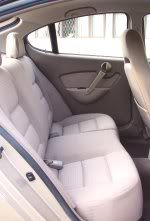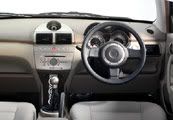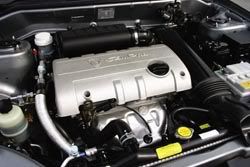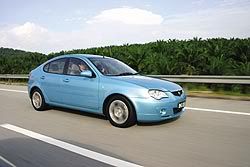The Emperor's new clothes - review of the Proton Gen.2
To those who know me, I've never had much luck with Proton cars - almost every one that I've ever owned, save for my beloved "Betsy" - a 1992 Proton Saga Megavalve Auto in the ubiquitous silver that was all the rage back then, many of the Proton vehicles that I've owned or driven have always been let down by dismal build quality, often resulting in unscheduled visits to the service centres for rectification work.
Proton's endeavour to shake off its bad reputation for its infamous build quality started with the Waja, introduced circa 2001, which was, to put it mildly, a disappointing effort. The Waja was still plagued by quality issues, notably the quality of its fittings and fixtures, which were no better, and in some cases, worse than my nephew's Fisher-Price toys.
To Proton's credit, Proton did incrementally upgrade the Waja, and today, the car's quality is actually not that shabby. Certainly isn't class-leading, but by all accounts, good enough for most buyers not to complain.
However, the subject of this review is the Gen.2 - a model Proton launched in early 2004 to an adoring public drawn by its stylish good looks. In many cases, the car sold on looks alone, and in this regard, Proton really out did itself....the car is a little beauty, looking compact, sporty - with an almost feline grace to the overall shape that wouldn't look out of place on a car costing many thousands more. 
Stylish lines of Proton's new baby.
Starting with the design of the car, the Gen.2 (silly name, really, because even in Malaysia we don't know what Gen1 was supposed to be) is actually based on the same platform as the Waja, and as such, inherits the Waja's relatively long (2600mm) wheelbase. That makes the Gen2 one of the largest cars in its class, wherein its competition (Honda City, Toyota Vios) have wheelbases that are at least 200mm shorter.
Normally, this would mean that the car would be incredibly spacious, but thats not the case here. The combination of unresolved packaging and that curvy roofline in the rear quarters that sweeps down at an acute angle to the stylish fastback tail has robbed the Gen2 interior of valuable headroom, so much so that anyone over 5ft 9in tall would feel his hair brush against the rooflining at the back of the car. 
Only the vertically-challenged need apply for the Proton's cramped rear quarters.
Front seats however, are spacious, and my 6ft 3in frame fits in comfortably without problems. Minor niggles are limited to the adjustment of the steering wheel - it wouldn't go high enough for a person my height, and the seat height adjustment, which even at it lowest setting, made you feel you were seated too high, almost SUV-like.
Ergonomics however, are spot on, with all the major controls falling easily to hand. I especially love the vertically stacked HVAC controls and the nicely integrated Blaupunkt CD stereo that lives up to Proton's reputation of fitting good-sounding stereos to its cars. 
The sporty dashboard with its neatly integrated Blaupunkt CD-stereo
The quality of the interior plastics are noticeably improved over Protons of yesteryear, and Proton has ingeniously hidden the cheapest materials it uses on the car by confining it to areas of the interior that users rarely touch or see. Take the door panel for example. While the door pulls feels like quality plastic, the rest of the door panel is unfortunately made of shiny, cheap, hollow plastic. Similarly, the dashboard top feels soft to the touch, but migrate downwards to the underside of the dash and you're met by nasty moulded plastic that feels significantly less robust.
Start the engine and you're greeted by a muted growl as the newly developed CAMPRO 1.6litre in-line 4 fires up. It's smooth at idle and sounds sporty when revved. This engine was developed in-house at Proton with the assistance of Lotus, and in most respects, its a modern engine, packing technology unheard of at this price level. Double overhead cams, electronic fuel injection, drive-by-wire throttle control and an in-house developed Electronic Control Unit has helped optimise this engine's output, and the results show - even without Proton's much anticipated CPS (Camshaft Profiling System) variable valve timing mechanism, the CAMPRO makes an impressive 110bhp. It also makes decent amounts of torque - 148Nm of it, which places it on-par with its competition from Toyota and Honda, both of which makes fine engines for the Vios and the City respectively.
The CAMPRO in-line four that powers the Gen.2 - powerful but noisy and lacking in mid-range torque
The Gen2 reviewed was equipped with the automatic transmission, which is shared with the Waja but reprogrammed for use in the smaller Gen2. It has newly-incorporated gradient sensing features that holds a lower gear when it senses the car on declines, but otherwise its the same tried and tested Mitsubishi design.
Driving the Gen2 is a mixed bag of good and bad. Equipped with MacPherson stuts up front and a multi-link rear suspension tuned by Proton-owned Lotus, the Gen2 handles well, taking corners with the enthusiasm of a true hot-hatch. The front end grips tenaciously and the rear follows with little drama. At higher speeds, the front does tend to want to run wide, but thats more likely attributed to the low-rent Sime Tyres that Proton has chosen as factory fitments. An upgrade to better rubber will likely see a marked improvement in the car's handling charateristics.
Ride quality however, is patchy - it never fully settles into a restful gait, constantly bobbing around unless the car is fully loaded. In this regard, the Waja, with its heavier body, copes much better, riding serenely where the Gen2 would literally bounce along.
To its credit, the car always feels well planted and the suspension settings allow it to maintain ham-fisted control over body movements even on the worst of roads, never once bottoming out or feeling like the suspension was under-damped. Where the Waja suspension would rapidly run out of ideas and start to noisily clunk and bang into ruts and potholes, the Gen2's suspension just sorts it out and moves on to the next one with an almost teutonic arrogance to its gait.
Fitted with unusually large 15 inch disc brakes front and rear, braking performance is reassuring, with the car stopping surefootedly every time with negligible brake fade, which is impressive considering the version I drove wasn't even equipped with anti-lock brakes.
My favourite gripe with Proton has always been their refusal to include basic safety features such as ABS and Airbags on their cars, and this attitude has not changed with the Gen2. Whilst all export models are fitted with ABS and Airbags, local Gen2's soldier on with nothing more than seatbelts to boast as safety equipment.
Coming back to the Gen2's drivetrain, the one thing that strikes you about the CAMPRO is its distinct lack of grunt in its midrange. Between 1,500rpm and 2,500rpm, the engine feels lathergic to say the least.
Stomp on the accelerator pedal and you're met by a lot of noise, but little action from the engine bay. The reason behind this is clear - although the CAMPRO produces a class competitive 148Nm of torque, it delivers its maximum thrust at a sky-high 4,000rpm. On a manual transmission car, I suspect, this would be less of a problem as a downshift or two is all thats needed to keep the engine running at this speed.
On the automatic however, its a constant annoyance as the gearbox, if left to its own devices, is programmed to keep the engine below 3,000rpm, right where the flat spot is. So you're essentially left with just 500rpm to play with before the box shifts to a higher gear and gets bogged down again in the flat spot that defines the CAMPRO's power delivery.
The Gen2 at speed - tops out at 185km/h but getting there is a noisy affair
The CAMPRO also lags behind its competition in terms of noise & refinement suppression. The engine sounds fine below 2,000rpm, but once extended beyond this rev range, things quickly fall apart, with the engine getting increasingly raucous. Loud induction noise, coupled with an odd whining (presumably from the air-conditioner's compressor) and a characterless blare from the exhaust conspire to make any effort to drive this car the way its able chassis begs you to, a futile one, and is best experienced, if you absolutely insist, with silicone ear-plugs stuffed in both ears.
Vibrations also upset the calmness of the cabin at anything above 3,000rpm, which is a pity, because thats when the engine really gets into its groove and starts to produce meaningful mid-range thrust. I suspect some additional work on the sound proofing of the Gen2's engine bay and mounting of the CAMPRO in the bodyshell would do wonders to cut down on this problem.
The new gradient sensing feature of the gearbox is, in my opinion, a major annoyance. At any speed below 90km/h, the gearbox is overtly sensitive to downhill stretches of road, shifting to a lower gear at the slightest hint of a decline. I've driven the car on the North-South highway, and because some stretches are limited to 90km/h, downhill, the car literally screams its way down as the engine is forced to rev to 3,500rpm and the gearbox holds a lower gear steadfastedly unless you accelerate past 90km/h, which is not only illegal, but dangerous when going downhill.
Gearshift quality has also taken a downturn when compared to the box's fitment in the Waja. 1st to 2nd shifts are crude, to put it mildly, and the gearbox appears to have inherited the Waja 1.8's fuzzy logic programming, which was more fuzzy than logical on most accounts. I've never been a fan of the Waja 1.8's Renault derived drivetrain, but the engineers at Proton seemingly disagrees with my view that the French drivetrain has quirks best understood if you spoke French and drank copious amounts of wine.
The Gen2 I drove also suffered from a multitude of build quality problems. Rattling back seats, clunking front suspension, loose trim panels, squeaking dashboard, loose door lock knobs and frightful panel fit & finish marred what could have been Proton's chance to prove its sceptics wrong. In many ways, the Gen2 is more poorly assembled that the company's long-in-the-tooth Wira. Panel gaps are huge and inconsistent, panels have a wavy finish to them, notably on the car's lower sill cover, and the paint on the car was prone to chipping at the slightest hint of a stone. Over the 2,000km that I had the Gen2, the nose section of the bonnet had already picked up numerous stone chips.
Proton knows this and already, the Gen2 is the subject of an on-going general recall to replace its front suspension struts which has an inherent design flaw, causing it to clunk over bumps.
Problems like this do not affect the car's driveability, but buyers nowadays expect more. With the motor sector gradually opening up and being brought in-line with AFTA, buyers now have more options open to them. In a market that is gradually being filled with Korean and Japanese offerings like the Toyota Avanza, Chevrolet Aveo, Hyundai Getz and the upcoming Chery models from China, Proton cannot continue to flog inferior-quality cars to Malaysians and expect them to buy them merely on the fact that it handles well. Truth of the matter is the handling capabilities that Proton so proudly banks on to market its cars is rarely ever taken advantage of by an average owner. What matters more is that the car runs trouble free when new and continues to do so for many miles to come.
Whilst the Gen2 is a decent car for the RM 58k that Proton asks for it, the sad truth is that it could have been much better. And Proton must realise that it has to be better to succeed as a viable international car maker. A drive in any of its natural competition - the Hyundai Getz, Chevrolet Aveo, Toyota Vios or the Honda City, merely highlights how much Proton has to do to make its cars competitive without the pricing advantage. To add insult to the injury, a drive in a Perodua Kelisa recently highlighted to me just how much better Peroduas are built. The car I drove had over 20,000km's on the clock but it still drove like new with nary a squeak or rattle anywhere.
So at the end of the day, whilst the Gen2 will undoubtedly be a sales success, thanks to keen pricing and style in abundance, its quality is disappointing and some elements of its drivetrain will need serious work before the car can truly be called a world-class effort by Proton. One hopes the upcoming CPS-equipped Gen2 will address all these shortcomings.

